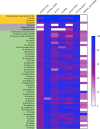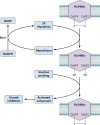Functions of nitroreductases in mycobacterial physiology and drug susceptibility
- PMID: 39772630
- PMCID: PMC11841060
- DOI: 10.1128/jb.00326-24
Functions of nitroreductases in mycobacterial physiology and drug susceptibility
Abstract
Tuberculosis is a respiratory infection that is caused by members of the Mycobacterium tuberculosis complex, with M. tuberculosis (Mtb) being the predominant cause of the disease in humans. The approval of pretomanid and delamanid, two nitroimidazole-based compounds, for the treatment of tuberculosis encourages the development of more nitro-containing drugs that target Mtb. Similar to the nitroimidazoles, many antimycobacterial nitro-containing scaffolds are prodrugs that require reductive activation into metabolites that inhibit the growth of the pathogen. This reductive activation is mediated by mycobacterial nitroreductases, leading to the hypothesis that these nitroreductases contribute to the specificity of the nitro prodrugs for mycobacteria. In addition to their prodrug-activating activities, these nitroreductases have different native activities that support the growth of the bacteria. This review summarizes the activities of different mycobacterial nitroreductases with respect to their activation of different nitro prodrugs and highlights their physiological functions in the bacteria.
Keywords: Mycobacterium; antimicrobials; nitroreductase.
Conflict of interest statement
R.B.A. is the founder and owner of Tarn Biosciences, Inc., a company that is working to develop new antimycobacterial drugs.
Figures





Similar articles
-
Predicting nitroimidazole antibiotic resistance mutations in Mycobacterium tuberculosis with protein engineering.PLoS Pathog. 2020 Feb 7;16(2):e1008287. doi: 10.1371/journal.ppat.1008287. eCollection 2020 Feb. PLoS Pathog. 2020. PMID: 32032366 Free PMC article.
-
Structure-activity relationships of antitubercular nitroimidazoles. 3. Exploration of the linker and lipophilic tail of ((s)-2-nitro-6,7-dihydro-5H-imidazo[2,1-b][1,3]oxazin-6-yl)-(4-trifluoromethoxybenzyl)amine (6-amino PA-824).J Med Chem. 2011 Aug 25;54(16):5639-59. doi: 10.1021/jm1010644. Epub 2011 Jul 26. J Med Chem. 2011. PMID: 21755942 Free PMC article.
-
PA-824 kills nonreplicating Mycobacterium tuberculosis by intracellular NO release.Science. 2008 Nov 28;322(5906):1392-5. doi: 10.1126/science.1164571. Science. 2008. PMID: 19039139 Free PMC article.
-
[Development of antituberculous drugs: current status and future prospects].Kekkaku. 2006 Dec;81(12):753-74. Kekkaku. 2006. PMID: 17240921 Review. Japanese.
-
Reduction of polynitroaromatic compounds: the bacterial nitroreductases.FEMS Microbiol Rev. 2008 May;32(3):474-500. doi: 10.1111/j.1574-6976.2008.00107.x. Epub 2008 Mar 18. FEMS Microbiol Rev. 2008. PMID: 18355273 Review.
Cited by
-
Defining the mechanism of action of the nitrofuranyl piperazine HC2210 against Mycobacterium abscessus.NPJ Antimicrob Resist. 2025 Jun 14;3(1):55. doi: 10.1038/s44259-025-00124-0. NPJ Antimicrob Resist. 2025. PMID: 40517180 Free PMC article.
References
-
- Cellitti SE, Shaffer J, Jones DH, Mukherjee T, Gurumurthy M, Bursulaya B, Boshoff HI, Choi I, Nayyar A, Lee YS, Cherian J, Niyomrattanakit P, Dick T, Manjunatha UH, Barry CE 3rd, Spraggon G, Geierstanger BH. 2012. Structure of Ddn, the deazaflavin-dependent nitroreductase from Mycobacterium tuberculosis involved in bioreductive activation of PA-824. Structure 20:101–112. doi:10.1016/j.str.2011.11.001 - DOI - PMC - PubMed
-
- Gurumurthy M, Mukherjee T, Dowd CS, Singh R, Niyomrattanakit P, Tay JA, Nayyar A, Lee YS, Cherian J, Boshoff HI, Dick T, Barry CE III, Manjunatha UH. 2012. Substrate specificity of the deazaflavin-dependent nitroreductase from Mycobacterium tuberculosis responsible for the bioreductive activation of bicyclic nitroimidazoles. FEBS J 279:113–125. doi:10.1111/j.1742-4658.2011.08404.x - DOI - PMC - PubMed
-
- Rifat D, Li SY, Ioerger T, Shah K, Lanoix JP, Lee J, Bashiri G, Sacchettini J, Nuermberger E. 2020. Mutations in fbiD (Rv2983) as a novel determinant of resistance to pretomanid and delamanid in Mycobacterium tuberculosis. Antimicrob Agents Chemother 65:e01948-20. doi:10.1128/AAC.01948-20 - DOI - PMC - PubMed
Publication types
MeSH terms
Substances
Grants and funding
LinkOut - more resources
Full Text Sources

